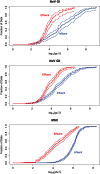Meta-Analysis of the Reduction of Norovirus and Male-Specific Coliphage Concentrations in Wastewater Treatment Plants
- PMID: 25934626
- PMCID: PMC4551176
- DOI: 10.1128/AEM.00509-15
Meta-Analysis of the Reduction of Norovirus and Male-Specific Coliphage Concentrations in Wastewater Treatment Plants
Abstract
Human norovirus (NoV) is the leading cause of foodborne illness in the United States and Canada. Wastewater treatment plant (WWTP) effluents impacting bivalve mollusk-growing areas are potential sources of NoV contamination. We have developed a meta-analysis that evaluates WWTP influent concentrations and log10 reductions of NoV genotype I (NoV GI; in numbers of genome copies per liter [gc/liter]), NoV genotype II (NoV GII; in gc/liter), and male-specific coliphage (MSC; in number of PFU per liter), a proposed viral surrogate for NoV. The meta-analysis included relevant data (2,943 measurements) reported in the scientific literature through September 2013 and previously unpublished surveillance data from the United States and Canada. Model results indicated that the mean WWTP influent concentration of NoV GII (3.9 log10 gc/liter; 95% credible interval [CI], 3.5, 4.3 log10 gc/liter) is larger than the value for NoV GI (1.5 log10 gc/liter; 95% CI, 0.4, 2.4 log10 gc/liter), with large variations occurring from one WWTP to another. For WWTPs with mechanical systems and chlorine disinfection, mean log10 reductions were -2.4 log10 gc/liter (95% CI, -3.9, -1.1 log10 gc/liter) for NoV GI, -2.7 log10 gc/liter (95% CI, -3.6, -1.9 log10 gc/liter) for NoV GII, and -2.9 log10 PFU per liter (95% CI, -3.4, -2.4 log10 PFU per liter) for MSCs. Comparable values for WWTPs with lagoon systems and chlorine disinfection were -1.4 log10 gc/liter (95% CI, -3.3, 0.5 log10 gc/liter) for NoV GI, -1.7 log10 gc/liter (95% CI, -3.1, -0.3 log10 gc/liter) for NoV GII, and -3.6 log10 PFU per liter (95% CI, -4.8, -2.4 PFU per liter) for MSCs. Within WWTPs, correlations exist between mean NoV GI and NoV GII influent concentrations and between the mean log10 reduction in NoV GII and the mean log10 reduction in MSCs.
Copyright © 2015, American Society for Microbiology. All Rights Reserved.
Figures



Similar articles
-
Pathogenic Enteric Viruses and Microbial Indicators during Secondary Treatment of Municipal Wastewater.Appl Environ Microbiol. 2015 Sep;81(18):6436-45. doi: 10.1128/AEM.01218-15. Epub 2015 Jul 10. Appl Environ Microbiol. 2015. PMID: 26162869 Free PMC article.
-
Norovirus and FRNA bacteriophage determined by RT-qPCR and infectious FRNA bacteriophage in wastewater and oysters.Water Res. 2013 Sep 15;47(14):5222-31. doi: 10.1016/j.watres.2013.06.008. Epub 2013 Jun 24. Water Res. 2013. PMID: 23850211
-
Inactivation of Human Norovirus Genogroups I and II and Surrogates by Free Chlorine in Postharvest Leafy Green Wash Water.Appl Environ Microbiol. 2017 Oct 31;83(22):e01457-17. doi: 10.1128/AEM.01457-17. Print 2017 Nov 15. Appl Environ Microbiol. 2017. PMID: 28887415 Free PMC article.
-
Molecular epidemiology and genotype distributions of noroviruses and sapoviruses in Thailand 2000-2016: A review.J Med Virol. 2018 Apr;90(4):617-624. doi: 10.1002/jmv.25019. Epub 2018 Jan 23. J Med Virol. 2018. PMID: 29315631 Review.
-
Occurrence of coliphage in raw wastewater and in ambient water: A meta-analysis.Water Res. 2019 Apr 15;153:263-273. doi: 10.1016/j.watres.2018.12.058. Epub 2019 Jan 11. Water Res. 2019. PMID: 30735956 Free PMC article.
Cited by
-
Evaluation of a Male-Specific DNA Coliphage Persistence Within Eastern Oysters (Crassostrea virginica).Food Environ Virol. 2019 Jun;11(2):120-125. doi: 10.1007/s12560-019-09376-2. Epub 2019 Mar 27. Food Environ Virol. 2019. PMID: 30919239
-
Direct potable reuse microbial risk assessment methodology: Sensitivity analysis and application to State log credit allocations.Water Res. 2018 Jan 1;128:286-292. doi: 10.1016/j.watres.2017.10.034. Epub 2017 Oct 27. Water Res. 2018. PMID: 29107913 Free PMC article.
-
Global Distribution of Human-Associated Fecal Genetic Markers in Reference Samples from Six Continents.Environ Sci Technol. 2018 May 1;52(9):5076-5084. doi: 10.1021/acs.est.7b04438. Epub 2018 Apr 16. Environ Sci Technol. 2018. PMID: 29570973 Free PMC article.
-
Risk Assessment of Norovirus Illness from Consumption of Raw Oysters in the United States and in Canada.Risk Anal. 2022 Feb;42(2):344-369. doi: 10.1111/risa.13755. Epub 2021 Jun 13. Risk Anal. 2022. PMID: 34121216 Free PMC article.
-
Salmonella risks due to consumption of aquaculture-produced shrimp.Microb Risk Anal. 2018 Aug;9:22-32. doi: 10.1016/j.mran.2018.04.001. Epub 2018 Apr 13. Microb Risk Anal. 2018. PMID: 30525084 Free PMC article.
References
Publication types
MeSH terms
Substances
LinkOut - more resources
Full Text Sources
Medical
Research Materials
Miscellaneous

